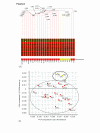Investigation of the molecular profile of basal cell carcinoma using whole genome microarrays
- PMID: 17173689
- PMCID: PMC1770933
- DOI: 10.1186/1476-4598-5-74
Investigation of the molecular profile of basal cell carcinoma using whole genome microarrays
Abstract
Background: Skin cancer accounts for 1/3 of all newly diagnosed cancer. Although seldom fatal, basal cell carcinoma (BCC) is associated with severe disfigurement and morbidity. BCC has a unique interest for researchers, as although it is often locally invasive, it rarely metastasises. This paper, reporting the first whole genome expression microarray analysis of skin cancer, aimed to investigate the molecular profile of BCC in comparison to non-cancerous skin biopsies. RNA from BCC and normal skin specimens was analysed using Affymetrix whole genome microarrays. A Welch t-test was applied to data normalised using dCHIP to identify significant differentially-expressed genes between BCC and normal specimens. Principal component analysis and support vector machine analysis were performed on resulting genelists, Genmapp was used to identify pathways affected, and GOstat aided identification of areas of gene ontology more highly represented on these lists than would be expected by chance.
Results: Following normalisation, specimens clustered into groups of BCC specimens and of normal skin specimens. Of the 54,675 gene transcripts/variants analysed, 3,921 were differentially expressed between BCC and normal skin specimens. Of these, 2,108 were significantly up-regulated and 1,813 were statistically significantly down-regulated in BCCs.
Conclusion: Functional gene sets differentially expressed include those involved in transcription, proliferation, cell motility, apoptosis and metabolism. As expected, members of the Wnt and hedgehog pathways were found to be significantly different between BCC and normal specimens, as were many previously undescribed changes in gene expression between normal and BCC specimens, including basonuclin2 and mrp9. Quantitative-PCR analysis confirmed our microarray results, identifying novel potential biomarkers for BCC.
Figures


References
-
- Hafner C, Hartmann A, Knuechel R, Dietmaier W, Landthaler M, Vogt T. Molecular genetic analysis excluded implantation metastasis of basal cell carcinoma. Arch Pathol Lab Med. 2003;127:1221–1224. - PubMed
-
- Ionescu DN, Arida M, Jukic DM. Metastatic basal cell carcinoma: four case reports, review of literature, and immunohistochemical evaluation. Arch Pathol Lab Med. 2006;130:45–51. - PubMed
Publication types
MeSH terms
LinkOut - more resources
Full Text Sources
Research Materials

